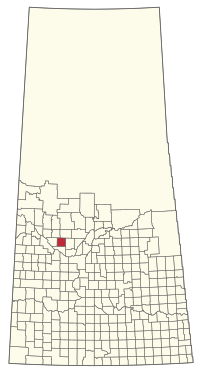Rural municipality in Saskatchewan, Canada
| Douglas No. 436 | |
|---|---|
| Rural municipality | |
| Rural Municipality of Douglas No. 436 | |
 Location of the RM of Douglas No. 436 in Saskatchewan Location of the RM of Douglas No. 436 in Saskatchewan | |
| Coordinates: 52°44′17″N 107°40′01″W / 52.738°N 107.667°W / 52.738; -107.667 | |
| Country | Canada |
| Province | Saskatchewan |
| Census division | 16 |
| SARM division | 6 |
| Formed | December 13, 1909 |
| Government | |
| • Reeve | Nick Partyka |
| • Governing body | RM of Douglas No. 436 Council |
| • Administrator | Darrin Beaudoin |
| • Office location | Speers |
| Area | |
| • Land | 820.37 km (316.75 sq mi) |
| Population | |
| • Total | 350 |
| • Density | 0.4/km (1/sq mi) |
| Time zone | CST |
| • Summer (DST) | CST |
| Area code(s) | 306 and 639 |
The Rural Municipality of Douglas No. 436 (2016 population: 350) is a rural municipality (RM) in the Canadian province of Saskatchewan within Census Division No. 16 and SARM Division No. 6.
History
The RM of Douglas No. 436 incorporated as a rural municipality on December 13, 1909.
Geography
Communities and localities
The following urban municipalities are surrounded by the RM.
The following unincorporated communities are within the RM.
- Localities
Demographics
| Year | Pop. | ±% |
|---|---|---|
| 1981 | 653 | — |
| 1986 | 590 | −9.6% |
| 1991 | 521 | −11.7% |
| 1996 | 478 | −8.3% |
| 2001 | 425 | −11.1% |
| 2006 | 383 | −9.9% |
| 2011 | 331 | −13.6% |
| 2016 | 350 | +5.7% |
| Source: Statistics Canada via Saskatchewan Bureau of Statistics | ||
In the 2021 Census of Population conducted by Statistics Canada, the RM of Douglas No. 436 had a population of 342 living in 130 of its 173 total private dwellings, a change of -2.3% from its 2016 population of 350. With a land area of 814.37 km (314.43 sq mi), it had a population density of 0.4/km (1.1/sq mi) in 2021.
In the 2016 Census of Population, the RM of Douglas No. 436 recorded a population of 350 living in 152 of its 173 total private dwellings, a 5.7% change from its 2011 population of 331. With a land area of 820.37 km (316.75 sq mi), it had a population density of 0.4/km (1.1/sq mi) in 2016.
Attractions
Government
The RM of Douglas No. 436 is governed by an elected municipal council and an appointed administrator that meets on the second Wednesday of every month. The reeve of the RM is Nick Partyka while its administrator is Charles W. Linnell. The RM's office is located in Speers.
Transportation
See also
References
- "Pre-packaged CSV files - CGN, Canada/Province/Territory (cgn_sk_csv_eng.zip)". Government of Canada. July 24, 2019. Retrieved May 23, 2020.
- ^ "Rural Municipality Incorporations (Alphabetical)". Saskatchewan Ministry of Municipal Affairs. Archived from the original on April 21, 2011. Retrieved May 9, 2020.
- ^ "Municipality Details: RM of Douglas No. 436". Government of Saskatchewan. Retrieved October 23, 2021.
- ^ "Population and dwelling counts, for Canada, provinces and territories, and census subdivisions (municipalities), 2016 and 2011 censuses – 100% data (Saskatchewan)". Statistics Canada. February 8, 2017. Retrieved May 1, 2020.
- "Saskatchewan Census Population" (PDF). Saskatchewan Bureau of Statistics. Archived from the original (PDF) on September 24, 2015. Retrieved May 9, 2020.
- "Saskatchewan Census Population". Saskatchewan Bureau of Statistics. Retrieved May 9, 2020.
- "Population and dwelling counts: Canada, provinces and territories, census divisions and census subdivisions (municipalities), Saskatchewan". Statistics Canada. February 9, 2022. Retrieved April 13, 2022.
- "The Crooked Bush". Tourism Saskatchewan. Government of Saskatchewan. Retrieved March 28, 2024.
